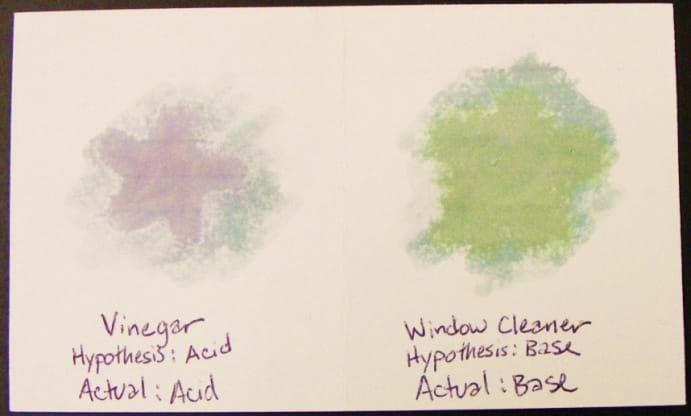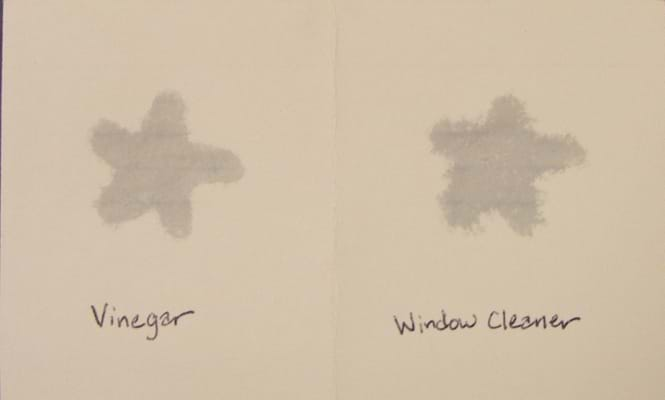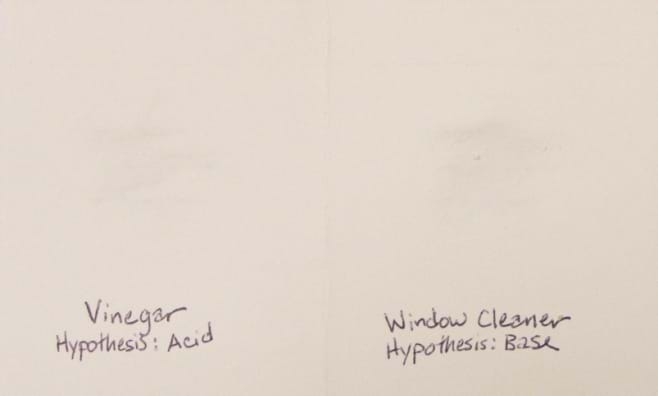Quick Look
Grade Level: 10 (9-11)
Time Required: 1 hour
(This includes time for the "ink" to dry.The activity itself takes much less time. Thus, have students write with the "ink" early in the hour, so concepts can be explained while the "ink" is drying.)
Expendable Cost/Group: US $0.10
Group Size: 2
Activity Dependency: None
Subject Areas: Chemistry, Life Science, Physical Science
Summary
Students hypothesize whether vinegar and ammonia-based glass cleaner are acids or bases. They create designs on index cards using these substances as invisible inks. After the index cards have dried, they apply red cabbage juice as an indicator to reveal the designs.
Engineering Connection
Acid/base chemistry includes concepts applied across many engineering disciplines. Engineers use their knowledge of acids and bases to complete tasks such as designing non-corrosive infrastructure, batteries, chemical fertilizers and food preservation methods. Writing in an invisible ink that can be read using an acid/base indicator was commonly used by engineers, inventors and military leaders during the American Revolutionary War to communicate secret messages. Acid rain is a worldwide environmental problem that has been addressed by environmental engineers. Acid rain can alter the pH of water and soil and have negative effects on plants and animals. Environmental engineers conduct studies to evaluate the significance of environmental hazards, advise on treatment and containment, and help to develop regulations to improve or prevent polluting conditions.
Learning Objectives
After this activity, students should be able to:
- Hypothesize whether a liquid is an acid or base.
- Identify whether a liquid is an acid or base based on its color interaction with cabbage juice.
- Explain how acids and bases were used during the American Revolution to send spy letters.
- Describe how engineers use acids and bases.
Educational Standards
Each TeachEngineering lesson or activity is correlated to one or more K-12 science,
technology, engineering or math (STEM) educational standards.
All 100,000+ K-12 STEM standards covered in TeachEngineering are collected, maintained and packaged by the Achievement Standards Network (ASN),
a project of D2L (www.achievementstandards.org).
In the ASN, standards are hierarchically structured: first by source; e.g., by state; within source by type; e.g., science or mathematics;
within type by subtype, then by grade, etc.
Each TeachEngineering lesson or activity is correlated to one or more K-12 science, technology, engineering or math (STEM) educational standards.
All 100,000+ K-12 STEM standards covered in TeachEngineering are collected, maintained and packaged by the Achievement Standards Network (ASN), a project of D2L (www.achievementstandards.org).
In the ASN, standards are hierarchically structured: first by source; e.g., by state; within source by type; e.g., science or mathematics; within type by subtype, then by grade, etc.
International Technology and Engineering Educators Association - Technology
-
Students will develop an understanding of the role of society in the development and use of technology.
(Grades
K -
12)
More Details
Do you agree with this alignment?
State Standards
Texas - Science
-
Scientific investigation and reasoning. The student knows how to use a variety of tools and safety equipment to conduct science inquiry. The student is expected to:
(Grades
6 -
8)
More Details
Do you agree with this alignment?
-
Matter and energy. The student knows that interactions occur between matter and energy. The student is expected to:
(Grade
7)
More Details
Do you agree with this alignment?
-
Matter and energy. The student knows that matter is composed of atoms and has chemical and physical properties. The student is expected to:
(Grade
8)
More Details
Do you agree with this alignment?
-
Scientific processes. The student uses a systematic approach to answer scientific laboratory and field investigative questions. The student is expected to:
(Grades
9 -
12)
More Details
Do you agree with this alignment?
-
design and implement investigative procedures, including making observations, asking well-defined questions, formulating testable hypotheses, identifying variables, selecting appropriate equipment and technology, and evaluating numerical answers for reasonableness;
(Grades
9 -
12)
More Details
Do you agree with this alignment?
Materials List
Each group needs:
- 6 small, cup-like containers
- 3 cotton swabs
- pipette
- spoon
- index card, one per person
- pencil, one per person
- Basically Acidic Lab Sheet, one per student
To share with the entire class:
- lemon juice
- ammonia-based glass/window cleaner
- vinegar
- baking soda
- red cabbage juice
Worksheets and Attachments
Visit [www.teachengineering.org/activities/view/uoh_hp_activity_acidic_ink] to print or download.Introduction/Motivation
Introduction Part 1
(Begin by showing a video clip from Harry Potter and the Prisoner of Azkaban. In the clip, Harry is given the magical Marauder's Map, which shows all of Hogwarts, the wizard school, and the locations of people in it, in real time. The map is a blank piece of parchment until magical words are spoken over it. When the words are spoken, ink appears.)
What happened in that video clip? (Expect students to say that Harry was given a map with appearing ink.) Does appearing or disappearing ink exist in the real world, or is it purely magical? (Some students may have experience playing with disappearing or invisible ink, so they may say that invisible and disappearing ink are real.) If invisible ink is real what is it made of? Do you think we can make it ourselves using common household materials? What are some uses for disappearing ink?
(Since the "ink" in this activity needs time to dry, have students complete Procedure Part 1 at this time. Then, proceed to conduct Introduction Part 2 and the lesson while the index cards are drying.)
Introduction Part 2
Invisible ink played a large part in the American Revolution. Spies wrote letters using invisible ink. To do this, a spy would write a regular letter using regular ink, and between the lines write a secret message using invisible ink. A symbol would often be put in the corner of the letter to tell the receiver how to read the secret message. What are some ways that you think the reader could have read the secret message?
Can you think of a movie that showed this concept being used? (Show a video clip from National Treasure. In the clip, the three main characters apply acid and heat to the back of the Declaration of Independence to reveal a message written in invisible ink.)
What were the two methods used in the video to reveal the invisible ink? (Answer: Heat and lemons/acid.) What is an acid? What is an example of an acid? Why might acids be important to engineers? (This provides a transition to talk about acids, bases and their real-world uses in engineering.) How might acids and bases affect our environment? (One answer is acid rain, which can harm plants and animals, as well as human-made structures and statues.) What is acid rain? (The answer is any type of precipitation that is acidic, which is not the normal pH of rain.) What types of people try to solve the problem of acid rain? (The answer is scientists and environmental engineers who track down the causes, usually human industry, and work to prevent further pollution-caused acid rain.)
Procedure
Procedure Part 1 - Invisible Ink
Acids are compounds that usually dissolve in water, taste sour, and react with bases to form salts. Bases are compounds that react with acids to form salts and taste bitter. An indicator is a substance that visually shows, usually by a color change, the presence of an acid or base in a solution.
The indicator used in this activity is red cabbage juice. The juice can be purchased at some grocery stores or made by blending and straining red cabbage and water. Red cabbage contains anthocyanin, which is a pigment that is red in strongly acidic solutions, blue in weakly basic solutions, and colorless in strongly basic solutions.
Before the Activity
- Gather materials and make copies of the lab sheets.
- Divide the class into groups of two students each.
- Give each group six small, cup-like containers. Put ~20 ml of red cabbage juice in each of two of the containers and ~20 ml of lemon juice, vinegar, ammonia-based window cleaner and baking soda, respectively, in the other four cups.
- Give each group a pipette, spoon and three cotton swabs.
- Give each student a pencil, an index card and a lab sheet.

Figure 1. An index card with wet "invisible ink" marks made with vinegar and window cleaner.
With the Students
- Direct students to each fold his or her index card in half, bringing the two short sides of the index card together. Unfold the index card and place it line-side down.
- Near the bottom of the left side of the card, write "vinegar," and on the bottom right side write "window cleaner" (see Figure 1).
- On the left side of the card, use a cotton swab dipped in vinegar to paint a simple design or shape. Do the same on the right side, but use a new cotton swab dipped in the window cleaner liquid. *It is important to not dip the same cotton swab in both liquids!* The liquid bleeds into the paper, so simple designs, like stars, smiley faces or big capital letters, work best.
- Set the cards aside to dry.
- Complete Introduction Part 2 and the associated lesson.
Procedure Part 2 - Reactive Liquids

- Direct each group to pipette some lemon juice and add a few drops of it to one of the cups of cabbage juice. Stir it with the handle end of the spoon. On the lab sheets, write down observations and whether lemon juice is an acid or base.
- Direct each group to spoon a small amount of baking soda into the cabbage juice and lemon juice mixture. Stir it with the handle end of the spoon. On the lab sheets, write down observations and whether baking soda is an acid or base.

Procedure Part 3 - Reappearing Ink
- Ask students to each hypothesize whether vinegar and window cleaner are acids or bases. Direct them to write their hypotheses on the index card, below where they wrote the "invisible" substance names (see Figure 2).
- Make sure the index cards are dry (see Figure 2).
- Direct groups to dip the third, unused cotton swab in the untouched cabbage juice. Swab the juice over the area where the invisible ink shapes were drawn. The designs will appear (see Figure 3), the vinegar design in pink and the window cleaner design in blue! On their lab sheets, have students record their observations and whether vinegar and window cleaner are acids or bases.
- Conclude by holding a class discussion to share results and conclusions. Have students hand in their lab sheets for grading.
Vocabulary/Definitions
acid: A compound that usually dissolves in water, has a sour taste, reacts with a base to form a salt, and turns litmus paper red.
base: A compound that reacts with an acid to form a salt, has a bitter taste, and turns litmus paper blue.
engineer: A person who applies science and mathematics to create solutions for the benefit of humanity and our world.
environmental engineering: The application of science and engineering principles to improve the environment.
indicator: A substance used to show visually (as by change of color) the presence of acid or base in a solution.
pH indicator: Shows via color change whether a substance is an acid or base.
pH scale: Rates how acidic or basic a substance is; ranges from 0 (most acidic) to 14 (most basic), with 7 as neutral.
Assessment
Pre-Activity Assessment
Questions/Answers: Ask students: Is invisible ink real? What might it be made of? After watching the National Treasure clip, ask: What are acids and bases? What are they used for?
Activity Embedded Assessment
Prediction: After learning about acids and bases and gaining some experience with the indicator, ask students to hypothesize whether their invisible "inks" are acids or bases.
Post-Activity Assessment
Lab Sheets: At activity end, have students complete and turn in the Basically Acidic Ink Lab Sheets, which demonstrate their knowledge of the topic. The lab sheets include some higher thinking application questions, such as "How do engineers use acids and bases?"
Investigating Questions
- What happened in the Harry Potter and the Prisoner of Azkaban movie clip?
- Does appearing or disappearing ink exist in the real world, or is it purely magical?
- If invisible ink is real, what is it made of?
- Do you think we can make it ourselves using common household materials?
- What are some uses for disappearing ink?
- What are some ways that you think that a person trying to read invisible ink could have made the secret message appear?
- What were the two methods used in National Treasure to reveal the invisible ink?
- What is an acid?
- What is an example of an acid?
- Why are acids and bases important?
- How do engineers use acids and bases?
- How were acids and bases used during the Revolutionary War?
- Using cabbage juice as an indicator, how can one tell if a solution is an acid or a base?
- Are these items acids or bases? Lemon juice, baking soda, vinegar, ammonia-based window cleaner.
Troubleshooting Tips

Be alert for cross-contamination of the acidic and basic solutions. Remind students to dip each cotton swab in only one solution.
Some students may want to add lemon juice to one sample of cabbage juice and baking soda to the other. They should add both the lemon juice and baking soda to one sample, leaving the other sample of cabbage juice alone (it will be used to reveal the invisible ink later in the activity).
Additional Multimedia Support
Borrow from your school or public library DVDs of the Harry Potter and the Prisoner of Azkaban and National Treasure movies, so you can show students the invisible ink clips. If not available, describe the scenes, since most students are familiar with the movies and will be able to recall the scenes and describe them more fully to other classmates.
Subscribe
Get the inside scoop on all things TeachEngineering such as new site features, curriculum updates, video releases, and more by signing up for our newsletter!More Curriculum Like This

Students learn the basics of acid/base chemistry in a fun, interactive way by studying instances of acid/base chemistry found in popular films such as Harry Potter and the Prisoner of Azkaban and National Treasure. Students learn what acids, bases and indicators are and how they can be used, includi...

Under the "The Science Behind Harry Potter" theme, a succession of diverse complex scientific topics are presented to students through direct immersive interaction. Student interest is piqued by the incorporation of popular culture into the classroom via a series of interactive, hands-on Harry Potte...

Students are introduced to acids and bases, and the environmental problem of acid rain. Students also conduct a simple experiment to model and discuss the harmful effects of acid rain on our living and non-living environment.

Students are introduced to the differences between acids and bases and how to use indicators, such as pH paper and red cabbage juice, to distinguish between them. They learn why it is important for engineers to understand acids and bases.
References
Dictionary .com. Lexico Publishing Group, LLC. Accessed March 22, 2010. http://www.dictionary.com
Foster, Kate, et al. Spy Letters of the American Revolution: Secret Methods and Techniques: Invisible Ink.13 May 1999. Accessed 24 March 2010. http://www2.si/umich.edu//spies/index-main2.html
Plants and pH. 2004. Intel Young Scientist. Accessed March 22, 2010. http://angel-patti03.tripod.com/id2.html
Copyright
© 2013 by Regents of the University of Colorado; original © 2010 University of HoustonContributors
Rachel Howser; Nicole Stewart; Christine Hawthorne; Corey BurtonSupporting Program
National Science Foundation GK-12 and Research Experience for Teachers (RET) Programs, University of HoustonAcknowledgements
This digital library content was developed by the University of Houston's College of Engineering under National Science Foundation GK-12 grant number DGE 0840889. However, these contents do not necessarily represent the policies of the NSF and you should not assume endorsement by the federal government.
Last modified: August 19, 2020









User Comments & Tips